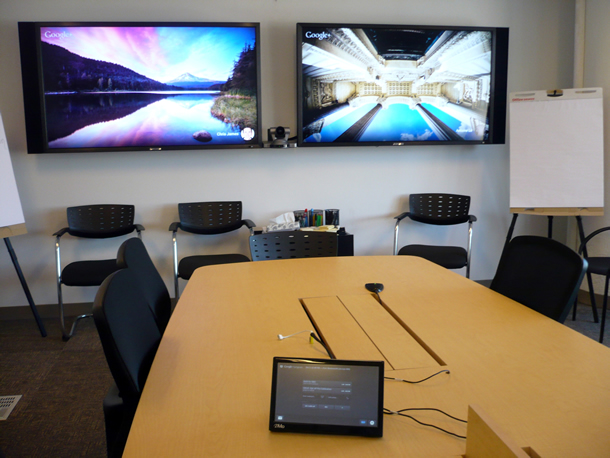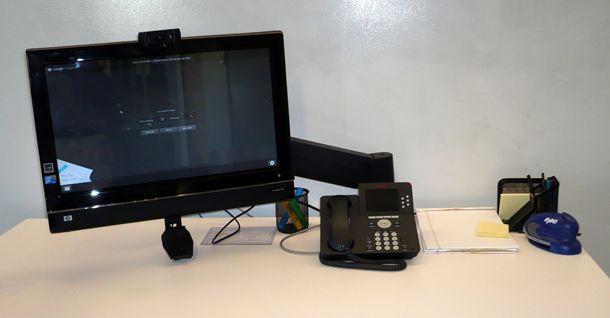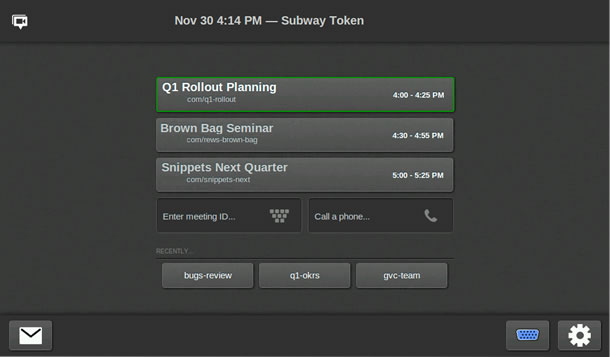Conventional wisdom and research studies suggest that having team members work together in the same place is a significant factor in team success. Co-located teams are more likely to be aware of day-to-day issues and include members who are more engaged with each other. They form common ground and personal loyalty that fosters more interaction, encourages discussion, and builds trust. Serendipitous information exchange is more likely when workers are sitting together than when they are hundreds of miles apart.
Remote collaboration is a reality, though, for many modern businesses. In some cases, narrowly focused project teams are formed for short durations; in other cases, long-term product-oriented teams draw on geographically dispersed talent pools. Even groups that are co-located often interact with co-workers in other locations, including team members working from home.
Google is a global company with employees scattered all over the world. Even when managers try to keep product groups close together, business and personal priorities inevitably override these plans. Meetings rarely occur without at least one person participating from outside the primary office. In some cases, large projects have entire sub-teams collaborating from different regions in the U.S. and other parts of the world. Meetings span distance, time zones, languages, and cultures.
Researching Remote Collaboration
Over the course of a year, our team at Google carried out five studies to understand how remote collaboration was working within the company. Our research goal was straightforward: determine how well remote collaboration was working and what could be improved. This meant studying the use of the recently installed videoconferencing (VC) system, gauging user satisfaction, and exposing other factors that impact the effectiveness of remote collaboration.
We began with structured interviews with twenty-four employees who were members of geographically dispersed teams. These interviews gave us a general picture of employee satisfaction with the new videoconferencing system as well as insight into the technical, physical, social, and cultural challenges that distributed teams face. The interviews also identified several pockets of employees using “video portals:” always-on videoconferencing between remote team members.
Our second study explored how the video portals were being used and how effective they were. We conducted twenty in-depth interviews with members of six teams. We also studied the teams’ physical environments and monitored dozens of hours of portal usage.
Next, we felt that a third, observational study could help validate what users had told us, as well as detect unreported patterns and unrecognized problems relating to VC-mediated meetings. We wanted researchers from different geographical areas to serve as additional meeting observers, so we trained peer UX researchers in other locations on ethnographic methods. In the end, nine researchers observed a total of twenty meetings from six locations.
Our fourth study investigated employees who have their own dedicated VC hardware in addition to their regular computers. We wanted to know what benefits the extra hardware provided and how the use of those devices differed from using one’s desktop or laptop computer to join VCs. We interviewed seventeen people with this configuration and mined usage logs for additional insight.
The final component of our research was an employee survey on VC and remote collaboration. The survey was designed to collect quantitative data on user satisfaction and remote meeting frequency, along with additional qualitative input from a broad spectrum of employees. The survey was distributed to a random sample of 1,250 employees worldwide (excluding top executives and recent hires), and resulted in nearly 500 completed responses.
Remote Collaboration Is Working
In our studies, employees consistently viewed their remote collaborations as successful and attributed the success primarily to the widespread adoption of VC in the company. A quarter of our survey sample reported having multiple VC meetings a day; another 50 percent reported having VC meetings “once a day” or “a few times a week.” Analyses of VC system logs support these numbers.
In late 2012, each workday saw upwards of 20,000 connections of dedicated VC devices. Assuming that an average VC meeting involves two to three dedicated units, we estimate that 6,500–10,000 meetings per day involved VC by the end of 2012. This does not include laptop-to-laptop video calls.
Videoconferencing technology has helped employees overcome many traditional obstacles commonly associated with distributed teams. In the interviews, people using VC suggested two main factors as keys to its success: ubiquity and ease-of-use, which together significantly reduced the effort required to set up and participate in a video call. Over 6,000 dedicated VC units are available in conference rooms throughout the company (see Figures 1 and 2).


VC setup is integrated with the calendar application and requires a single extra mouse-click. Joining a videoconference is similarly elegant: one click on the calendar displayed in a conference room or one click on a link in the meeting invitation on your laptop (see Figure 3). Screen sharing, also easy and quick to enable, is used pervasively.

meeting name starts the conference. The screen then lists various VC controls.
Many devices, including desktops, laptops, tablets, and smartphones, can be used to join a videoconference. Employees can (and do) join from anywhere in the world, provided they have reasonably fast Internet access. This means people can connect to meetings from a coffee shop, an airline lounge, the company shuttle bus, or a speeding train.
Voice-based conference calls have generally disappeared from the company except when dealing with customers and certain external partners. The ubiquity and ease of use of these systems means that the typical communication between employees who don’t sit together has migrated from telephone to VC. This holds true even for one-on-one impromptu consultations.
Study participants also pointed to other success factors for remote collaboration. Employees frequently rely on cloud-based file sharing, together with applications such as Google Docs, that support simultaneous editing and comment threads between and during VC meetings. Widespread use of instant messaging, often used to invite a collaborator to a private VC, adds immediacy to communication.
Technology is not the only thing that contributes to the quality of remote collaborations. Many interviewees were adamant in asserting the critical role played by periodic face-to-face team meetings, especially at the outset of working together. These meetings establish the trust, respect, and familiarity necessary to sustain a remote working partnership. Employees also pointed to an open and collaborative corporate culture as factors in allowing distributed teams to succeed. Finally, the abundance of shared spaces, such as conference rooms, phone rooms, and public areas, enables ad-hoc VCs to occur along with those scheduled in advance.
Video Portals
A video portal is a VC connection that is left on continuously. Typically, small VC units are set up in a team’s work area so that team members can see and be seen by other (remote) team members (see Figure 4). From log data, we estimated that more than fifty teams were using video portals, and the incidence was growing rapidly.

Across the six teams we studied, we found a range of video portal uses and interaction styles. We identified four different usage patterns:
- Spontaneous communication. By providing signals of “presence” and “availability,” and by eliminating start-up overhead, video portals encourage team members to converse, seek clarifications, and exchange updates. One participating team member captured the advantages quite well: “It does a pretty good job of simulating hallway conversations. A keyword catches your interest, you jump in and participate. You feel more like a team, and knowledge sharing is definitely better. This would not happen over chat or email.”
- Engagement of remote team members. A New York-based team had two members working from other locations. Both of them were fairly autonomous and did not require frequent interaction with their colleagues. However, they both found it useful to overhear conversations happening in New York. In fact, they often blocked the video and just monitored the audio. The portal kept them informed of what was happening with the product and allowed them to feel more like a part of the team.
- Handoff coordination. A network surveillance team monitors the production network round the clock in three shifts from three locations. During shift overlap, a video portal allows efficient information exchange between the shifts and provides a convenient channel for further follow-up on ongoing issues.
- Access to expertise. A user interface design team advertised their video portal to their parent organization and invited “drop-ins” for design consultation. In this way, they provided on-demand office hours. Their clientele did not need to set up appointments or send email; they just joined the video portal, and if a team member was available, initiated their query. Other teams have moved to a similar model for consulting.
Video portal users have reported that seeing each other during the day helped maintain a cohesive team and a sense of shared identity. Research has found that this is important for developing highly effective teams.
Limitations of Videoconferencing in Remote Collaboration
We encountered two principal challenges to remote collaboration that even VC does not overcome. The first seems intractable: time zones. With team members in distant longitudes, real-time conversations require some participants to rise early or stay up late.
The other challenge is surmountable with new technology: the low-tech whiteboard plays a key role in design collaboration, and there’s currently no effective digital equivalent available commercially. We expect to see tools emerge to fill this gap.
Unique to Google?
We were curious to know if Google is unusual in its pervasive use of videoconferencing, so we conducted an informal email poll among friends and professional contacts. We received responses from sixty-six people working at more than fifty different companies, mostly in the technology and finance sectors. Although screen-sharing was common, by far the majority of distributed meetings relied on conference call technology. None of the larger companies in our sample had a significant number of VC-equipped rooms.
Only 15 percent participated in more videoconferences than voice-only conference calls, often using Skype or Google+ Hangouts instead of specially equipped conference rooms. Nearly all of the people in this group worked for small to mid-sized companies. While this poll is inconclusive, it suggests that most companies have not embraced VC. Small, resourceful businesses may lead the way in taking advantage of the VC channel.
We found that current VC technology can help to overcome many of the challenges associated with collaborating remotely. Under optimal conditions, including easily available and easy-to-use VC, when teams have overlapping work hours, and where familiarity and trust exist, the tyranny of distance can be alleviated significantly.一项关于 Google 团队内部远程协作的研究得出结论:普遍使用的视频会议有助于克服分布在不同地域的团队面临的诸多难题。
Google公司广泛采用了视频会议系统,在关于远程协作的研究中包含五项研究内容。日历集成功能简化了建立和加入视频会议 (VC) 的过程。员工经常会在任意地点通过专用设备或笔记本参加 VC。VC 已在很大程度上取代了内部电话。视频门户作为可以随时连线的 VC,从分布在不同地域的团队中涌现出来,以提高他们的生产力。尽管挑战仍然存在,但在一种充满支持精神的企业文化中,VC 的普遍使用推进了远程协作的成功。
文章全文为英文版Google 팀 내부의 원격 협력 연구 결과, 유비쿼터스 화상 회의가 지리적으로 분산된 팀이 직면한 여러 문제를 극복하는 데 도움이 되었다는 결론을 내렸습니다.
화상 회의가 널리 보급화된 Google에서 5가지의 연구를 통해 원격 협력을 진단하였습니다. 캘린더 통합으로 화상 회의(VC) 설정 및 참여가 간소화되었고, 직원들은 전용 장치를 통하거나 노트북을 통해 어디에서나 VC에 자주 참여합니다. VC는 사내의 전화 통화를 대부분 대체했습니다. VC에 있는 비디오 포털은 생산성 향상을 위해 지리적으로 분산된 팀들 간에 갑자기 등장했습니다. 나머지 다른 도전 과제에도 불구하고 지원하는 기업 문화에서 VC 사용이 보편화되어 원격 협력을 성공적으로 할 수 있게 되었습니다.
전체 기사는 영어로만 제공됩니다.Um estudo sobre colaboração remota dentro de equipes do Google concluiu que a videoconferência onipresente ajudou a superar muitos desafios enfrentados por equipes distribuídas geograficamente.
Cinco estudos examinaram a colaboração remota no Google, onde a videoconferência é amplamente utilizada. A integração dos calendários simplifica a criação e a participação nas de videoconferências (VCs). Os funcionários participam frequentemente de VCs por meio de equipamentos específicos ou de qualquer lugar do mundo a partir de seus notebooks. As VCs substituíram amplamente as chamadas telefônicas internas. Portais de vídeo – sempre em VCs – surgiram entre as equipes distribuídas geograficamente para melhorar sua produtividade. Apesar dos desafios remanescentes, o uso disseminado de VC dentro de uma cultura corporativa que a comporte permitiu uma colaboração remota de sucesso
O artigo completo está disponível somente em inglês.Googleチーム内のリモート・コラボレーションの研究から、ユビキタスなビデオ会議が、地理的に散在するチームが直面する課題を克服するのに役立っていることが分かった。
5つの研究が、ビデオ会議を頻繁に活用しているGoogleのリモート・コラボレーションを検証した。カレンダーの統一が、ビデオ会議(VC)の設定と会議への参加を簡素化している。社員は、専用のデバイスまたは自分のノートパソコンから場所を選ばずにVCに頻繁に参加する。VCは、社内の電話使用に大きく取って代わっており、VCに常に表示されるビデオポータルは、地理的に散在するチームの間の生産性向上のために広まっていった。課題は残るものの、(テクノロジーの受け入れに積極的な)企業文化を後ろ盾とするVC使用の普及により、リモート・コラボレーションの成功が可能になった。
原文は英語だけになりますUn estudio de colaboración remota dentro de los equipos de Google llegó a la conclusión de que la videoconferencia ubicua ha ayudado a superar muchos desafíos que enfrentan los equipos distribuidos en distintas zonas geográficas.
Cinco estudios examinaron la colaboración remota en Google, donde la videoconferencia se implementa ampliamente. La integración del calendario simplifica el establecimiento y la unión de las videoconferencias (VC). Los empleados participan con frecuencia en las VC a través de dispositivos especializados o desde cualquier lugar a través sus laptops. Las VC han reemplazado en gran medida las llamadas telefónicas internas. Los portales de video, siempre presentes en las VC, han surgido entre los equipos distribuidos en distintas zonas geográficas para mejorar su productividad. A pesar de los desafíos restantes, el uso generalizado de la VC dentro de una cultura corporativa de apoyo ha permitido una colaboración remota exitosa.
La versión completa de este artículo está sólo disponible en inglés.
